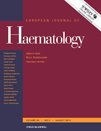Clinical features and prognostic model for extranasal NK/T-cell lymphoma
Abstract
Objective
The clinical features of extranodal natural killer (NK)/T-cell lymphoma (ENKL) that originates in extranasal sites are less well defined than those of ENKL that originates in nasal sites. Therefore, we compared the clinical characteristics and prognoses of patients with nasal ENKL and patients with extranasal ENKL.
Methods
We retrospectively analyzed 117 consecutive patients with ENKL that included 89 (76.1%) with nasal and 28 (23.9%) with extranasal disease.
Results
Extranasal ENKL was associated with more adverse clinical features than nasal ENKL, which included the presence of B symptoms, stage III/IV disease, ≥2 extranodal sites, and involvement of regional lymph nodes and bone marrow. After a median follow-up of 33.1 months (range, 0.7–152.2 months), the median overall survival (OS) of patients with extranasal and nasal NK/T-cell lymphoma was 8.6 and 86.5 months, respectively. Multivariate analysis revealed that extranasal NK/T-cell lymphoma was a significant factor that affects OS. When patients with extranasal ENKL were classified into low-risk and high-risk categories according to the Korean Prognostic Index (KPI) and International Prognostic Index (IPI), these indices categorized the two groups with significantly different survival outcomes (P = 0.025 and 0.035, respectively).
Conclusions
Patients with extranasal ENKL have worse clinical outcomes than those with nasal ENKL. The KPI and IPI appear useful for the prognosis of patients with extranasal ENKL.




